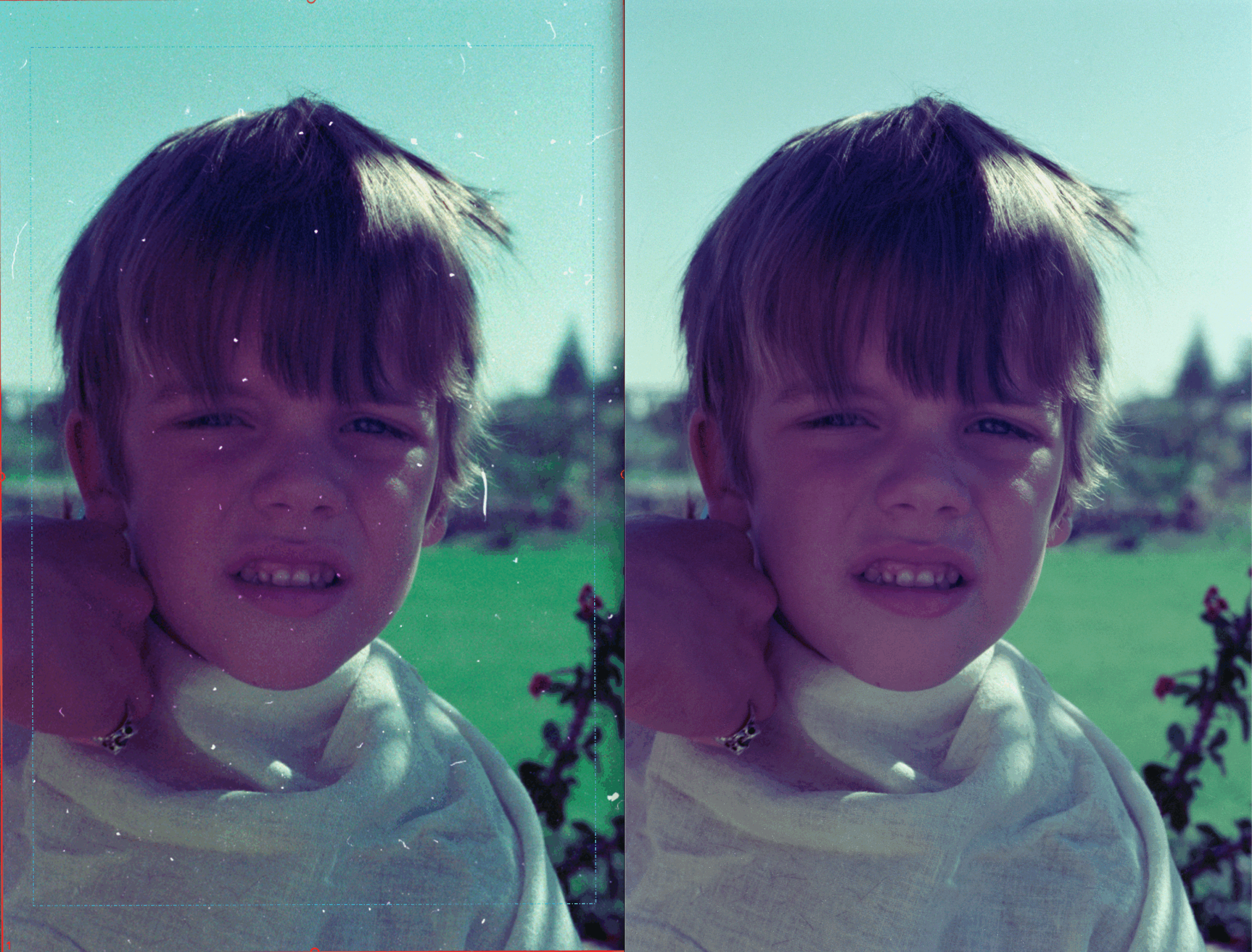You carefully preserved those family slides and negatives for decades—only to scan them and discover what looks like a blizzard of white specks, squiggly hairs, and minor to major scratches. Don’t worry, it’s not your fault—and thankfully, there’s a smart technology designed to help: infrared dust and scratch removal.
If you’ve ever wondered how we make old film look clean again without retouching every speck by hand, here’s your answer.
What Is Infrared Dust & Scratch Removal?
Infrared (IR) scratch and dust removal is a technique used by high-end film scanners that utilizes a secondary light source—invisible to the human eye—to detect surface imperfections.
Here’s how it works:
- A standard scan captures the image using visible light.
- An infrared scan is performed simultaneously. This IR light passes through the film but is blocked by dust, lint, and scratches.
- The scanner compares the two scans, detects the defects, and applies intelligent corrections—filling in missing image data using neighboring pixels.
The result? A clean, restored image without the need for manual retouching.
Why It Works Only on Film (and Not on Prints)
Infrared cleaning only works on transparent materials like negatives and slides. That’s because IR light can pass through film, allowing the scanner to “see” surface disruptions. On reflective materials like prints or paper, the technique doesn’t work—there’s nowhere for the IR beam to go.
So if you’re digitizing:
- 35mm, medium-format, or large-format negatives — IR cleaning is incredibly effective.
- Slides (mounted transparencies) — also an excellent candidate.
- Printed photos — IR won’t help; dust removal must be manual or software-assisted.
Limitations: Why It Doesn’t Work for Most Black-and-White Negatives
It’s important to note that infrared scratch removal usually doesn’t work on traditional black-and-white film. That’s because most B&W films use a silver halide emulsion that blocks or reflects infrared light completely—rendering the infrared channel ineffective.
In other words, the scanner can’t distinguish dust and scratches from the image content because the film appears opaque under infrared light. This is why IR cleaning is typically disabled automatically when scanning B&W film, and manual cleanup is often required instead.
Some modern or chromogenic black-and-white films (like Kodak BW400CN or Ilford XP2) can work with IR cleaning because they’re processed using color film chemistry (C-41) and lack the opaque silver layer.
Real-World Results: Before and After
Take a look at the example below (shown side by side):
You’ll see dozens of tiny white scratches and purple lint specks scattered across the original scan. On the right, after IR correction, the image appears smooth, clear, and ready to print or share.
And here’s another example using a historic air show photo:
In the uncorrected scan, the sky is full of tiny fibers and scan dust. The corrected version reveals a crisp, uninterrupted sky and improved contrast—without losing the organic film texture.
These improvements aren’t cosmetic fluff. They:
- Reduce the need for manual Photoshop cleanup
- Preserve fine detail by targeting only true defects
- Protect original content without over-smoothing
But Isn’t This “Too Good to Be True?”
Some people worry that automatic cleaning might alter the image too much. But modern IR-based algorithms—like those found in Digital ICE or similar tech—are highly precise. They distinguish between real image content (like grain, texture, or scratches embedded in the emulsion) and surface-level defects.
Importantly, the image content is preserved—even when damage is removed.
Still unsure? We keep both versions: the untouched raw scan and the IR-corrected version. That way, nothing is lost—and clients can always go back to the original if needed.
What You Need to Use IR Correction
Not all scanners can do this. Infrared dust and scratch removal is only available on scanners equipped with an IR channel. These include:
- Plustek OpticFilm series
- Pacific Image PowerFilm and PowerSlide scanners
- Epson V-series (with limitations)
- Nikon CoolScan film scanners (discontinued but legendary)
At MemoriesForward, we use multiple IR-capable scanners to match each film format, ensuring optimal results whether we’re handling a few slides or an entire archival estate.
Why This Matters for Your Family Archive
Scanning hundreds (or thousands) of images by hand is already time-consuming. Manually spotting and retouching every piece of lint? Nearly impossible.
Infrared cleaning provides:
- Faster turnaround without sacrificing quality
- Cleaner images ready for printing, framing, or sharing
- Better outcomes when using AI tools or color enhancement
It also avoids the common DIY frustration: scanning something, zooming in, and discovering it’s covered in gunk that wasn’t visible to the naked eye.
The Takeaway
Infrared dust and scratch removal is one of the quiet heroes of modern photo preservation. When used properly, it transforms rough, dusty scans into clean, high-resolution images—without erasing what makes film photography beautiful.
If you’re digitizing your own negatives, make sure your scanner supports infrared correction. If you’re working with a professional service, ask if they include IR-based cleaning.
At MemoriesForward, we use it as a default step in our negative and slide workflows. Because when it comes to preserving your family’s story, clarity—and care—make all the difference.
